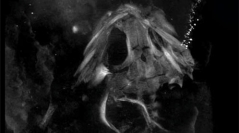

 Comptes Rendus Palevol
9 (6-7) - Pages 311-317
Comptes Rendus Palevol
9 (6-7) - Pages 311-317Studying ontogenetic features of fossil tetrapods is of major interest for investigating the adaptive strategies of early tetrapods to their palaeoenvironments. To determine the degree of calcification of skeletal elements, biologists have until now relied on X-ray radiographs of organisms or isolated bones, or on thin sections. An X-ray tomographic scan of Apateon, a Carboniferous – Permian branchiosaurid from the Autun Basin, France, reveals distinct density properties related to different mineralized tissues (calcified cartilage versus bone). The rendering of Apateon as a “test individual” provides a 3D map of the degrees of ossification of the axial and cranial elements. The combination of these anatomical observations with histological information from classical thin sections made in limb bones of several other specimens of the same locality allows the detailed determination of their ontogenetic stage. A comparison with the well-known specimens of the Saar-Nahe Basin, Germany, makes it possible to investigate the influence of different palaeoenvironments on ontogenetic features.
Ossification sequence, Ontogeny, Skeletochronology, Palaeoecology, Late Palaeozoic, Branchiosaurids